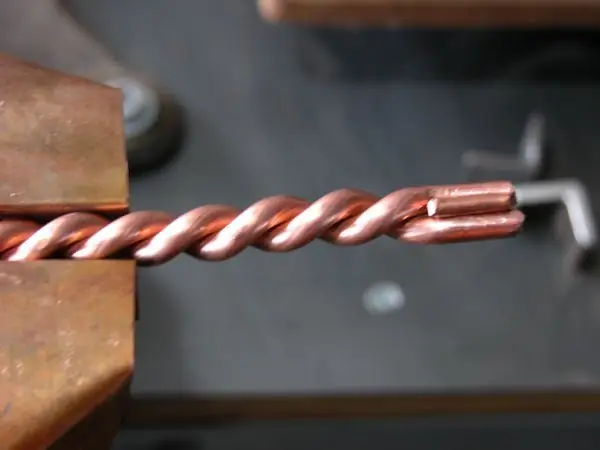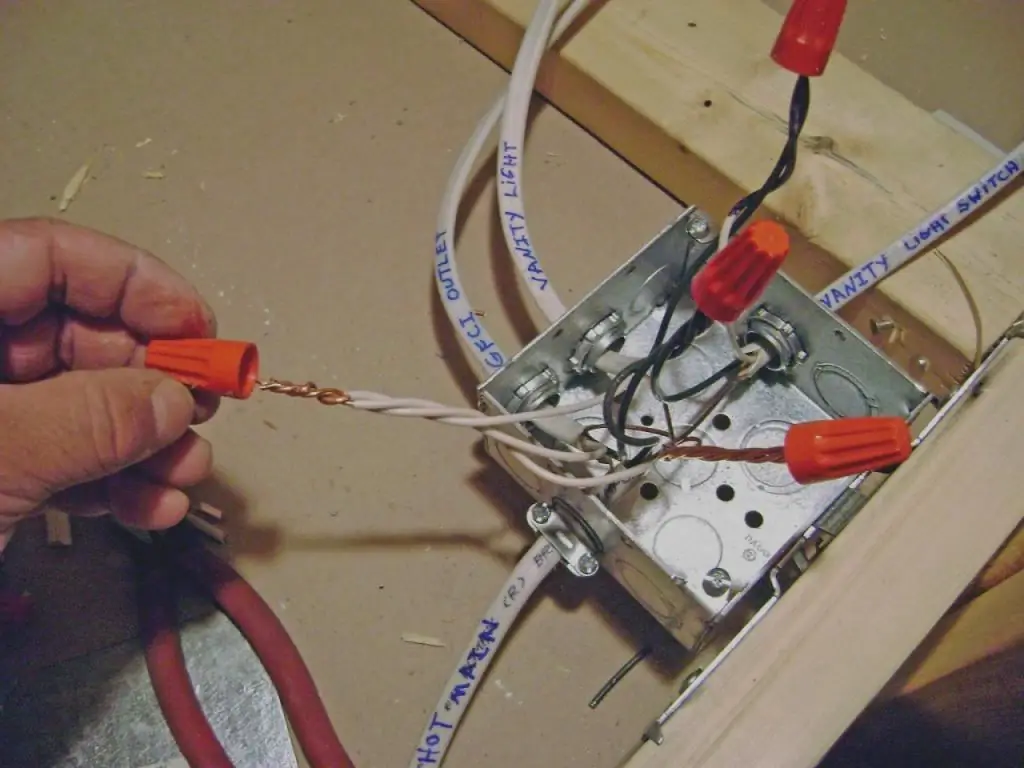2026 Author: Howard Calhoun | [email protected]. Last modified: 2025-01-24 13:10:47
Most common fires are caused by faulty electrical wiring. Fire can occur if the insulation is broken, as well as heating of the conductors at their junctions. Most often, when installing electrical wiring, twisting of wires is used. When twisting the wires, the pad has a small size, which leads to heating of the core when the load increases. It is this factor that leads to a sharp increase in temperature at the junction and, as a result, to ignition of the insulation.
Welding wires in a junction box is the most reliable connection of two wires in an electrical wiring. Therefore, before proceeding with the installation of the electrical network, it is necessary to carefully study the rules for carrying out such work. It would be useful to get acquainted with the step-by-step instructions for the welding process, as well as with the tips and recommendations of experienced installers.
Features of wire welding
Electrical wiring in modern houses is carried out with copper wire, aluminum was also used earlier. Therefore, we will mainly get acquainted with the welding process of copper conductors.
The peculiarity of copper conductors is that at a temperature of 300 ℃ the material becomes brittle, and at 1080 ℃ melting occurs. Therefore, it is very important to strictly observe the temperature regime in the process of welding wires in the junction box in order to avoid damage to the insulation and wires.
Elimination of overheating is carried out by connecting a cooling radiator to the place of twisting. It is better if the radiator is made of copper material and is tightly pressed against the twist.
The twist during welding must be placed vertically so that the molten metal takes the form of a spherical drop and covers the entire bundle of wires. Welding of stranded conductors is carried out after preliminary installation of a special crimp sleeve.
Advantages of connecting wires by welding
Do-it-yourself welding of wires in a junction box has an undeniable advantage over all types of conductor connection in that it allows you to achieve a complete absence of transient resistance that exists during bolting and twisting. This advantage is especially evident when connecting wiring for powerful power devices.
The advantages of welding wires in an electrical junction box are easier to see compared to the soldering process:
- no tinning of bare strands required;
- no filler material (tin) used;
- speedwork is much higher, so efficiency increases with a large number of connections;
- the ability to weld wires of any section.
The main disadvantage is the cost of the required equipment to make a quality connection.
Welding technology
Welding copper wires in a junction box is to create an electric arc, which melts the ends of the cores and creates a strong connection.
The wire connection technology is as follows:
- First of all, you need to prepare the wires for connection. To do this, we strip the wires from the insulation by 60-70 mm in order to exclude its melting during the welding process.
- Next, you need to connect the wires with a twist. The type of twist does not matter, since tight contact is formed by welding.
- The twist should be 50 mm long. The fluffy part of the conductors is carefully bitten off with wire cutters.
- At a distance of 25-30 mm from the end of the joint, we clamp the cores with a clamping device, which is the negative contact of the cable from the welding machine. It is for this device that the connected wires are held.
- Freely hand the holder with the electrode is brought to the junction.
- By briefly touching the end of a special electrode to the end part of the twist, an electric arc is ignited. Depending on the cross section of the wires and the current strength, the arc holding time (1-2 seconds) is selected.
- After joining the wires, which is determined by the emerging molten ball onat the end of the twist, we move the electrode aside, thereby interrupting the electric arc.
- Let the compound cool down.
- Further, the welded wires are insulated with heat shrink tubing and placed in a junction box.
Copper electrodes
Special copper-plated graphite or carbon electrodes are required for welding wires in a junction box. Such electrodes have a melting point several times higher than the melting of copper. They are easy to cut, which allows you to make rods of convenient length for work.

When using a homemade wire welding machine in a junction box, it is better to use carbon electrodes that have a higher electric arc temperature than graphite ones. This property allows welding at minimum currents.
Graphite electrodes are widely used in inverter welding, as such a device has a current adjustment. Welding with an inverter is of higher quality. If the factory rods are not available, battery-powered rods or brushes from an electric motor can be used.
Wire welding machines
The following types of welding are used for electrical installation work at industrial enterprises: spot, arc, plasma, ultrasonic, and sometimes semi-automatic welding of wires in a junction box. In domestic conditions, spot or arc type welding is most often used. at home to ensurewelding process, various transformers, inverters, as well as special devices for welding wires in the junction box are used.
Welding transformers
In order for the melting of the ends of the twist to occur qualitatively, the welding machine must produce the necessary current strength. The transformer of the welding machine provides adjustable current up to 400 A, while welding is carried out with special carbon electrodes coated with copper.
The use of a welding transformer is most justified in switchboards with a large number of connections, since it does not require the transfer of a heavy transformer.

To create a connection, you must turn on the transformer in the network, connect the negative contact to the clamp, and the positive contact to the electrode holder. Set the desired current strength on the device, depending on the cross section of the wires.
Inverter welding
To increase the mobility of welding, it is convenient to use an inverter machine with a minimum weight. Often, such devices are equipped with special straps that allow you to hang the device on your shoulder and connect wires even at a height.
Welding of wires in a junction box by an inverter can be carried out with alternating or direct current with a small voltage of 12-36 volts. Current adjustment is present in almost all inverter devices.

The process of welding with an inverter is similar to working with a transformer. The positive contact is connected to the electrode holder, and the negative contact is connected to the clamp. Welding with an inverter is much more comfortable and efficient, since there is no noise from the unit, and there is no flashing of electricity in the room due to the low power consumption of the machine.
Currently, manufacturers offer special welding machines for electricians. Such devices have a welding current adjustment range of 30-120 A, as well as a power of 1-1.5 kW. But unlike standard inverters, its weight and dimensions are significantly less. Also, small-sized devices are equipped with a special holder for carbon electrodes and a clamp with a wide platform.

Self-made welding machine
Usually, at home, it is easiest to make a wire welding unit in a transformer-type junction box. For these purposes, the following materials may be needed:
a transformer with a power of at least 600 W, which has a voltage on the secondary winding of about 30 V;

- crocodile clips are needed to fix the electrode;
- aluminum connection cables;
- you need a regulator to change the voltage;
- screwdrivers, pliers for connecting operations.
The process of self-assembly of the welding device is best done by people who are familiar with electrical engineering in order to properly assemble the circuit of the device.
Main stagesmanufacture as follows:
- First of all, you need to choose the body of the device, while paying attention to its weight, so that the device will be easier to move in the future.
- A switch must be installed between the transformer and the supply wire, which will supply current and turn off the unit.

- Connect the power wire to the transformer.
- From the secondary winding of the transformer with a heavy gauge wire, you need to connect the clamping device and the electrode holder.
Tips and tricks from experienced installers
To perform high-quality welding of wires in a junction box, it will not be superfluous to heed the advice of experienced installers:
- Cleaning wires from insulation must be done with extreme care to avoid damage to the core, which may later break.
- During the welding process, the strand must be placed in a vertical position so that the metal melts evenly.
- It is imperative to use protective equipment during welding (protective mask, heat-resistant gloves, special clothing).
- It is advisable for beginners to practice a little on separate pieces of wire in various modes of the welding process.

Remember that the connection of wires in the electrical junction box by welding guarantees the highest quality result and in further operation will not createproblems with the power supply system at home. The use of a do-it-yourself device will allow you to achieve the strength of the connecting contact no worse than factory models.
Recommended:
How to get Sberbank card details at an ATM: step by step instructions, tips and tricks

Wishing to transfer wages to a Sberbank card, customers often ask themselves what is required for this? In order for an employer or an individual to transfer funds to a plastic card, you must provide its details. You can recognize them by your passport at the bank office, but for this you will have to stand in line. It is much faster to look at the information in one of the thousands of terminals of the company. To do this, you need to have an idea of u200bu200bhow to get the details of a Sberbank card at an ATM
Twisting wires in a junction box: step by step instructions, tips from the masters

In the process of repair, the owners of a house or apartment are faced with the need to install junction boxes. The wires in them must be properly mounted. The most famous way in this case is twisting. It has certain advantages and disadvantages. Almost everyone can do the twisting in the junction box with their own hands. But at the same time, you need to learn about all the nuances of such work. How to twist will be discussed in the article
"Alfa-Bank", repayment of a loan via the Internet: step-by-step instructions, tips and tricks

Today, using a credit card is a completely natural process for many bank customers. According to statistics, transactions with credit cards are carried out in the amount of 80%. This confirms that the abundance of banking services is firmly rooted in people's lives
How to flash a house book: step by step instructions, tips and tricks

What is a house book? Why is this document needed? What does he represent? Where to get it? How to flash and number the house book? Possibility of automatic and manual flashing. Step by step algorithm. Drawing an inscription on the sticker, certification of the document. Firmware Tips and Tricks
How to learn to trade on the stock exchange: understanding the basics and rules of stock trading, tips and step-by-step instructions for novice traders

How to learn to trade on the stock exchange: understanding the basics and rules of stock trading, tips and step-by-step instructions for novice traders. What to pay attention to and where to be especially careful. Is it possible to trade without a broker

